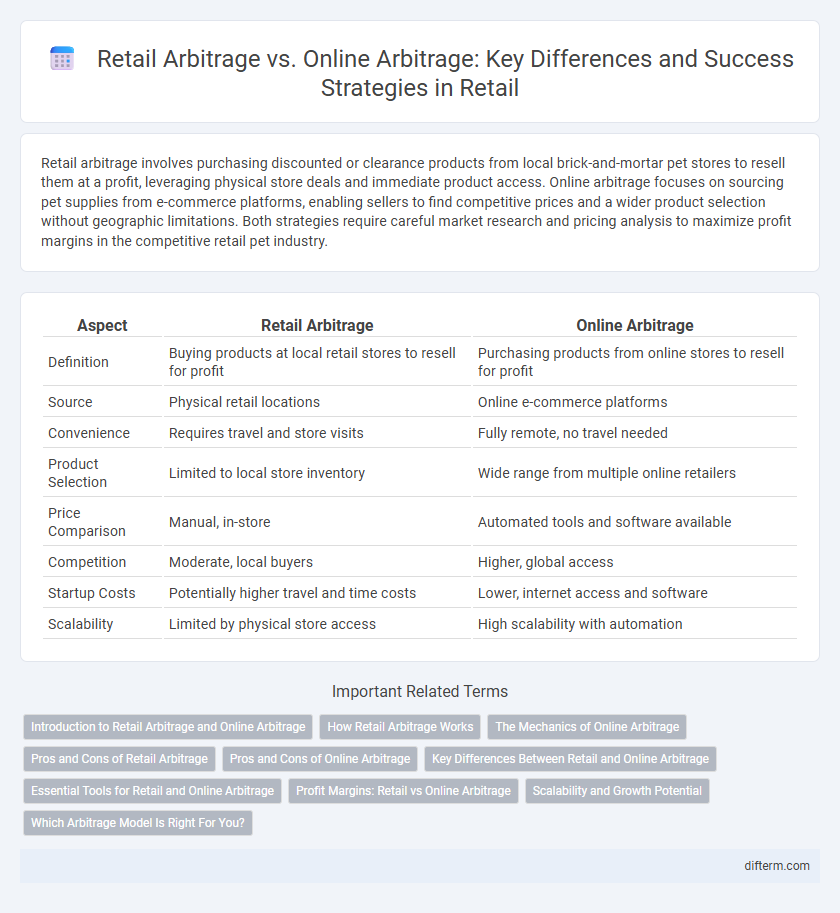Retail arbitrage involves purchasing discounted or clearance products from local brick-and-mortar pet stores to resell them at a profit, leveraging physical store deals and immediate product access. Online arbitrage focuses on sourcing pet supplies from e-commerce platforms, enabling sellers to find competitive prices and a wider product selection without geographic limitations. Both strategies require careful market research and pricing analysis to maximize profit margins in the competitive retail pet industry.
Table of Comparison
| Aspect | Retail Arbitrage | Online Arbitrage |
|---|---|---|
| Definition | Buying products at local retail stores to resell for profit | Purchasing products from online stores to resell for profit |
| Source | Physical retail locations | Online e-commerce platforms |
| Convenience | Requires travel and store visits | Fully remote, no travel needed |
| Product Selection | Limited to local store inventory | Wide range from multiple online retailers |
| Price Comparison | Manual, in-store | Automated tools and software available |
| Competition | Moderate, local buyers | Higher, global access |
| Startup Costs | Potentially higher travel and time costs | Lower, internet access and software |
| Scalability | Limited by physical store access | High scalability with automation |
Introduction to Retail Arbitrage and Online Arbitrage
Retail arbitrage involves purchasing discounted or clearance products from physical stores and reselling them online for profit, leveraging local retail opportunities. Online arbitrage, by contrast, sources products exclusively from online retailers, utilizing digital platforms to find price discrepancies between marketplaces. Both strategies require market research, product analysis, and price monitoring to maximize margins in competitive retail environments.
How Retail Arbitrage Works
Retail arbitrage works by purchasing discounted or clearance products from physical stores and reselling them online at higher prices, leveraging price discrepancies between offline and online markets. Sellers scan barcodes and analyze product demand using tools like Amazon Seller App or Scoutify to identify profitable items. This hands-on approach requires time for in-store sourcing, inventory management, and competitive pricing strategies to maximize profit margins.
The Mechanics of Online Arbitrage
Online arbitrage involves sourcing discounted or clearance products from e-commerce platforms and reselling them at a higher price on marketplaces like Amazon or eBay. The mechanics of online arbitrage rely heavily on software tools that scan multiple websites for price discrepancies, analyze profit margins, and track inventory availability in real-time. Efficient online arbitrage requires strong data analysis capabilities, automated repricing strategies, and reliable supplier relationships to maintain competitive advantage and maximize profitability.
Pros and Cons of Retail Arbitrage
Retail arbitrage offers the advantage of purchasing discounted products directly from physical stores, allowing sellers to inspect items for quality before buying, which reduces the risk of defective inventory. However, it requires significant time investment for in-person shopping and limits scalability compared to online arbitrage due to geographic constraints and store inventory variability. The potential for higher profit margins in retail arbitrage is balanced by challenges such as inconsistent stock availability and travel costs.
Pros and Cons of Online Arbitrage
Online arbitrage offers convenience by allowing retailers to purchase products from various online marketplaces without geographical constraints, thereby expanding inventory options. However, risks include inaccurate product condition descriptions and increased competition, which can reduce profit margins. The reliance on shipping times and return policies can also impact customer satisfaction and operational efficiency.
Key Differences Between Retail and Online Arbitrage
Retail arbitrage involves purchasing products from physical stores at a discount and reselling them online, capitalizing on local inventory discrepancies. Online arbitrage sources products from online retailers or marketplaces, leveraging digital tools to identify price gaps without geographic limitations. Key differences include the sourcing environment, product accessibility, and the immediacy of inventory assessment, with retail arbitrage relying on in-person scouting and online arbitrage depending on data analytics and virtual inventories.
Essential Tools for Retail and Online Arbitrage
Essential tools for retail arbitrage include barcode scanners, inventory management apps like Scoutify or InventoryLab, and price comparison tools to identify profitable deals in physical stores. Online arbitrage relies on software such as Keepa for price tracking, FBA calculator tools for profit estimation, and browser extensions like Tactical Arbitrage that automate product sourcing from e-commerce websites. Utilizing these specialized tools enhances efficiency, accuracy, and profitability in both retail and online arbitrage strategies.
Profit Margins: Retail vs Online Arbitrage
Retail arbitrage often yields higher profit margins due to the ability to purchase products at significant discounts from clearance sales and local store promotions. Online arbitrage offers more consistent access to inventory and price comparison tools, but typically features slimmer margins due to increased competition and fees. Sellers must weigh the higher upfront savings in retail arbitrage against the scalability and convenience of online arbitrage when optimizing profit margins.
Scalability and Growth Potential
Retail arbitrage involves purchasing products from physical stores at a discount and reselling them online, which limits scalability due to inventory constraints and time-intensive sourcing. Online arbitrage leverages digital platforms to source products, enabling faster inventory turnover and broader product selection that supports higher growth potential. Businesses focused on scalability benefit more from online arbitrage's streamlined processes and access to global suppliers.
Which Arbitrage Model Is Right For You?
Retail arbitrage involves purchasing discounted products from physical stores to resell at a profit, while online arbitrage focuses on sourcing deals from e-commerce platforms for resale. Choosing the right model depends on factors like inventory access, time commitment, and geographic location, with retail arbitrage requiring local store visits and online arbitrage offering more flexibility and scalability. Sellers aiming for convenience and broader product availability often prefer online arbitrage, whereas those leveraging local store clearance may find retail arbitrage more lucrative.
Retail Arbitrage vs Online Arbitrage Infographic

 difterm.com
difterm.com